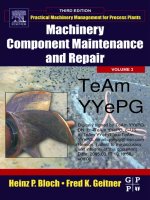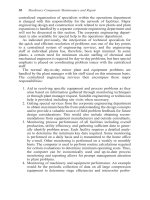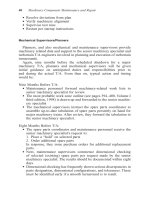Machinery Component Maintenance and Repair P2
Bạn đang xem bản rút gọn của tài liệu. Xem và tải ngay bản đầy đủ của tài liệu tại đây (1.76 MB, 10 trang )
centralized organization of specialists within the operations department
is charged with this responsibility for the network of facilities. Major
engineering design and construction work related to new plants and plant
expansions is handled by a separate corporate engineering department and
will not be discussed in this section. The corporate engineering depart-
ment is also available for special help to the operations department.
As indicated previously, the interjection of technical specialists for
the quick and efficient resolution of problems was one of the key points
to a centralized system of engineering services, and the engineering
staff at individual plants has, therefore, been kept minimal. In some
plants, a certain need for minimum on-site staffing of chemical and
mechanical engineers is required for day-to-day problems, but here special
emphasis is placed on coordinating problem issues with the centralized
staff.
The normal day-to-day minor plant and equipment problems are
handled by the plant manager with his staff sized on this minimum basis.
The centralized engineering services then encompass these major
responsibilities:
1. Aid in resolving specific equipment and process problems as they
arise based on information gathered through monitoring techniques
or through plant manager request. Suitable engineering or technician
help is provided, including site visits when necessary.
2. Getting special services from the corporate engineering department
to obtain maximum benefits from understanding the design concepts
and to provide a valuable source of field problem feedback for future
design considerations. This would also include obtaining recom-
mendations from equipment manufacturers and outside consultants.
3. Monitoring process performance of all facilities including overall
production, utility efficiency, and gathering sufficient data to gener-
ally identify problem areas. Each facility requires a detailed analy-
sis to determine the minimum key data required. Some monitoring
is performed on a daily basis and is transmitted to the home office
by e-mail. Other monitoring is performed on a weekly or monthly
basis. The computer is used to perform routine calculations required
for certain evaluations to determine minimum operating costs. Thus,
the computer can be economically used and up-to-date process
monitoring and reporting allows for prompt management attention
to plant problems.
4. Monitoring of machinery and equipment performance. An example
would be the periodic collection of data on all large compression
equipment to determine stage efficiencies and intercooler perfor-
30 Machinery Component Maintenance and Repair
mance since utility costs represent a significant portion of the total
operating costs in most petrochemical or air separation plants. Where
possible, the performance evaluations are translated into dollars so
that business decisions can be made. Figure 2-3 shows a simplified
computer program used for evaluating compressor efficiencies where
the results are translated into cost inefficiencies in dollars/day. Of
particular interest, also, is the increased use of field monitoring
methods as a key element in evaluating equipment performance. In
many cases, this represents the actual guidelines for determining
frequency of inspections.
5. Monitoring of plant and equipment performance by regular visits of
process and mechanical specialists to the facilities. This provides the
necessary final tie of the centralized group with plant personnel.
6. Establishing safety, technical, and operating procedures to provide
conformity to all plants.
7. The organization of corporate technical and training sessions for
plant personnel based on the management evaluation of need.
Summary
The system of plant maintenance and engineering services outlined has
been successful in achieving exceptionally low maintenance costs for a
nationwide complex of plants.
The overall maintenance system described herein has allowed a steady
reduction in plant personnel with corresponding savings. Actual mainte-
nance costs have steadily decreased as a percentage of original investment
costs without any allowance for labor and material escalation. With these
factors taken into account, the total maintenance cost reductions are
indeed significant.
The publishing of monitored data on plant performance and preventive
maintenance compliance has allowed for prompt management attention to
problems and has stimulated a noticeable spirit of competition among the
plants. Needless to say, it also serves as a valuable method of evaluating
plant manager performance.
Although the system described herein may not be directly applicable to
every large chemical complex for reasons of size or process type, the
general trends toward computerization, sophisticated equipment monitor-
ing methods and processes, cheaper transportation and communication
costs, are indicative of increasing advantages obtainable in the future from
centralized concepts in plant maintenance and engineering for multi-plant
corporations.
Maintenance Organization and Control for Multi-Plant Corporations 31
32 Machinery Component Maintenance and Repair
Figure 2-3. Simplified computer program used to evaluate compressor efficiencies.
Machinery Maintenance on the Plant Level
With this overview behind us, let’s get back to the machinery engineer’s
concerns on an individual plant level. As he of course knows, modern
turbomachines can run reliably for many years if designed, applied, and
operated correctly. As of 2004, the periods between inspection and over-
haul, commonly called “turnaround,” on machines in clean, noncorrosive
service can exceed eight years. It is easy to see how plant personnel may
have trouble remembering just how much time and effort are required to
successfully plan and execute an overhaul of a particular piece of equip-
ment. A proper turnaround involves preplanning and teamwork among
plant technical, warehouse, purchasing, safety, operations and mainte-
nance forces, as well as with the original equipment manufacturer and
other noncompany sources. In the case of sophisticated problems, con-
sultants and laboratories may also come into play to restore machinery to
a reliable, smooth-running, and efficient operation. Managing these
resources and documenting the results presents a real challenge to those
assigned the task of heading up the overhaul effort.
This segment of our text deals with turnaround management principles
that must be understood and considered by maintenance personnel on the
plant level.
Assignment of Qualified Personnel*
Major machinery overhauls require not only early planning input, but
also early designation of qualified personnel to execute planning and
related tasks. High quality machinery overhauls can be more consistently
achieved if machinery expertise is directly applied.
Process plants subscribing to this approach define, in specific outline
form, the responsibilities of supervisory and staff personnel involved in
turnaround (T/A) of major machinery. The outline explains the various
job functions involved in T/A activities and identifies the timing and
scheduling requirements which precede the actual shutdown.
The assignment of qualified personnel starts with the designation
of an overall T/A coordinator no later than nine months before the
scheduled shutdown. As of this time, the plant’s senior machinery
specialist is required to maintain formal communications with the T/A
coordinator.
Maintenance Organization and Control for Multi-Plant Corporations 33
* Based partly on material prepared by John D. Houghton and originally presented at the
Seventh Turbomachinery Symposium, Texas A&M University, College Station, Texas
(December 1978). Adapted by permission. Updated in 2004.
Among other duties, the T/A coordinator screens and approves the
planning and scheduling efforts of maintenance or contractor personnel
involved in major machinery T/A’s after the senior machinery specialist
has had an opportunity to review these efforts. Working hours and team
composition are to be determined jointly by the T/A coordinator and senior
machinery specialist.
Experience shows that a spare parts and materials coordinator should
also be designated no later than nine months before scheduled shutdown.
This person will generally be responsible for implementing spare parts
procurement requested by the senior machinery specialist and mechani-
cal supervisors. He will be required to forward up-to-date listings of parts
on hand to personnel requiring this information.
The plant senior machinery specialist is generally charged with respon-
sibility and authority to direct planning and execution of the machinery
portion of the T/A. His background and experience should make him
uniquely qualified for this job, and as senior resident expert he would be
thoroughly familiar with all machinery affected by the planned T/A.
A key job function is to be fulfilled by turbotrain T/A engineers. On
major machinery T/As it was found essential to have one or more of these
engineers assigned the responsibility of verifying the quality of execution
of all machinery overhaul tasks. If a given plant does not have enough
machinery engineers to man the job around the clock, affiliate loan or con-
tractor engineering personnel should be brought in for the duration. The
specific responsibilities of turbotrain T/A engineers have been described
as those of a machinery advisor and quality control person who augments
the mechanical supervisor and reports to the senior machinery specialist
for work direction and guidance. His responsibility and authority extends
from machine inlet nozzle to machine outlet nozzle and includes lube and
seal oil systems. His work begins after all required blinds have been
installed and ends after every item of machinery work is complete. He
will then turn over the machinery to the mechanical supervisor for removal
of blinds.
A turbotrain T/A engineer typically has a degree in an engineering
discipline (preferably mechanical engineering) and has had practical
machinery engineering experience for a minimum of five years. His past
assignments should have included active participation in major machin-
ery erection, commissioning, testing, operation, troubleshooting, and
repair. He normally performs work which involves conventional engi-
neering practices but may include a variety of complex features such as
resolution of conflicting design requirements, unsuitability of conven-
tional materials, and difficult coordination requirements. His normal
sphere of activity requires a broad knowledge of precedents in turbo-
machinery design and a good knowledge of principles and practices of
34 Machinery Component Maintenance and Repair









